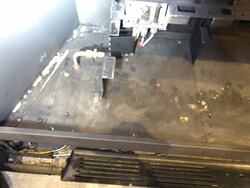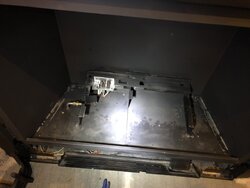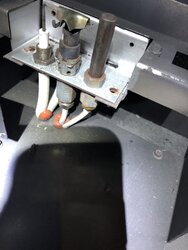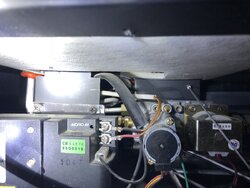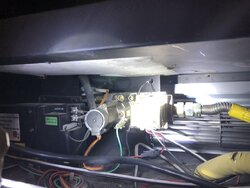My 6 year old natural gas Majestic 400DVBNSC7 recently began shutting off the main burner and attempting to relight itself three times. It fails each of the three times after burning for 3-7 minutes. Zero issues igniting or keeping the pilot light going. Tested the thermopile millivolts and it does seem low (80-130 after pilot cooked the thermopile for 3+ minutes). I did really scrub the thermopile good with scuff pad, sand paper, etc, and no improvement at all.
Figure it's time to replace the thermopile. But, I also figure that since the flame detector part (90 degree bent little piece, opposite the thermopile) also has some wear on it, I'd just replace the whole pilot assembly. How hard could that be...right?!
So I took out all of the easy stuff (logs, wool, grate) and vacuumed it out real good. Then, tracing the wires from the pilot assembly down below the "bottom" piece, it looked to me like I'd need to open up the panel sort of thing that is on the bottom to access the area where the wires go a lot more easily. Keep in mind that the wires are fire-stop siliconed in there too, so that would be easier to deal with this way too, I thought.
In order to get to the panel I wanted to unscrew, I had to unhook the burner. After unhooking the burner, I had access to the bottom panel and started undoing all the sheet metal screws that seemed to be holding it down.
After removing a bunch, I realized this panel was not lifting up. There is a sort of fuzzy insulation of sorts on the underneath of it, and it seems "glued" or "sealed"...as in, it didn't seem to like it when I was pulling up on it (or pushing up from underneath) and started to sort of have a tearing sound, so I stopped.
On top of this issue, after I stared at it some more, I realized that the gas line elbow with the brass fitting on the end of it would be completely in the way and not allow me to pull this panel up, even if I did keep going and tear the insulation layer up.
Can someone please help me with what I'm doing wrong here? If it is somehow going to be infinitely easier to replace just the thermopile, I'm willing to go that route (i.e. can I just unscrew the "head" of the old thermopile and put a new one on, and leave all the wiring alone). Otherwise, like I first mentioned, I'd like to replace the whole pilot assembly.
Attaching some pictures of what I'm dealing with.
Thanks!
Figure it's time to replace the thermopile. But, I also figure that since the flame detector part (90 degree bent little piece, opposite the thermopile) also has some wear on it, I'd just replace the whole pilot assembly. How hard could that be...right?!
So I took out all of the easy stuff (logs, wool, grate) and vacuumed it out real good. Then, tracing the wires from the pilot assembly down below the "bottom" piece, it looked to me like I'd need to open up the panel sort of thing that is on the bottom to access the area where the wires go a lot more easily. Keep in mind that the wires are fire-stop siliconed in there too, so that would be easier to deal with this way too, I thought.
In order to get to the panel I wanted to unscrew, I had to unhook the burner. After unhooking the burner, I had access to the bottom panel and started undoing all the sheet metal screws that seemed to be holding it down.
After removing a bunch, I realized this panel was not lifting up. There is a sort of fuzzy insulation of sorts on the underneath of it, and it seems "glued" or "sealed"...as in, it didn't seem to like it when I was pulling up on it (or pushing up from underneath) and started to sort of have a tearing sound, so I stopped.
On top of this issue, after I stared at it some more, I realized that the gas line elbow with the brass fitting on the end of it would be completely in the way and not allow me to pull this panel up, even if I did keep going and tear the insulation layer up.
Can someone please help me with what I'm doing wrong here? If it is somehow going to be infinitely easier to replace just the thermopile, I'm willing to go that route (i.e. can I just unscrew the "head" of the old thermopile and put a new one on, and leave all the wiring alone). Otherwise, like I first mentioned, I'd like to replace the whole pilot assembly.
Attaching some pictures of what I'm dealing with.
Thanks!


